remote control VOLVO S60 2013 Owner´s Manual
[x] Cancel search | Manufacturer: VOLVO, Model Year: 2013, Model line: S60, Model: VOLVO S60 2013Pages: 366, PDF Size: 6.85 MB
Page 24 of 366

01 Safety
Supplemental Restraint System (SRS) 01
22
General information
Warning symbols in the instrument panel
As an enhancement to the three-point seat
belts, your Volvo is equipped with a Supple-
mental Restraint System (SRS). Volvo's SRS
consists of seat belt pretensioners, front air-
bags, side impact airbags, a front passenger
occupant weight sensor, and inflatable cur-
tains. All of these systems are monitored by the
SRS control module. An SRS warning light in
the instrument panel (see the illustration) illu-
minates when the ignition is in modes I or II,
and will normally go out after approximately
6 seconds if no faults are detected in the sys-
tem.
Where applicable, a text message will also be
displayed when the SRS warning light illumi-
nates. If this warning symbol is not functioningproperly, the general warning symbol illumi-
nates and a text message will be displayed.
See also page 78 and page 80 for more
information about indicator and warning sym-
bols.
WARNING
•If the SRS warning light stays on after
the engine has started or if it illuminates
while you are driving, have the vehicle
inspected by a trained and qualified
Volvo service technician as soon as
possible.
•Never try to repair any component or
part of the SRS yourself. Any interfer-
ence in the system could cause mal-
function and serious injury. All work on
these systems should be performed by
a trained and qualified Volvo service
technician.
WARNING
If your vehicle has become flood-damaged
in any way (e.g., soaked carpeting/standing
water on the floor of the vehicle), do not
attempt to start the vehicle or insert the
remote key into the ignition slot before dis-
connecting the battery (see below). This
may cause airbag deployment which could
result in serious injury. Have the vehicle
towed to a trained and qualified Volvo serv-
ice technician for repairs.
Before attempting to tow the vehicle:
1. Switch off the ignition for at least
10 minutes and disconnect the battery.
2. Follow the instructions for manually
overriding the shiftlock system on page
120.
Page 38 of 366
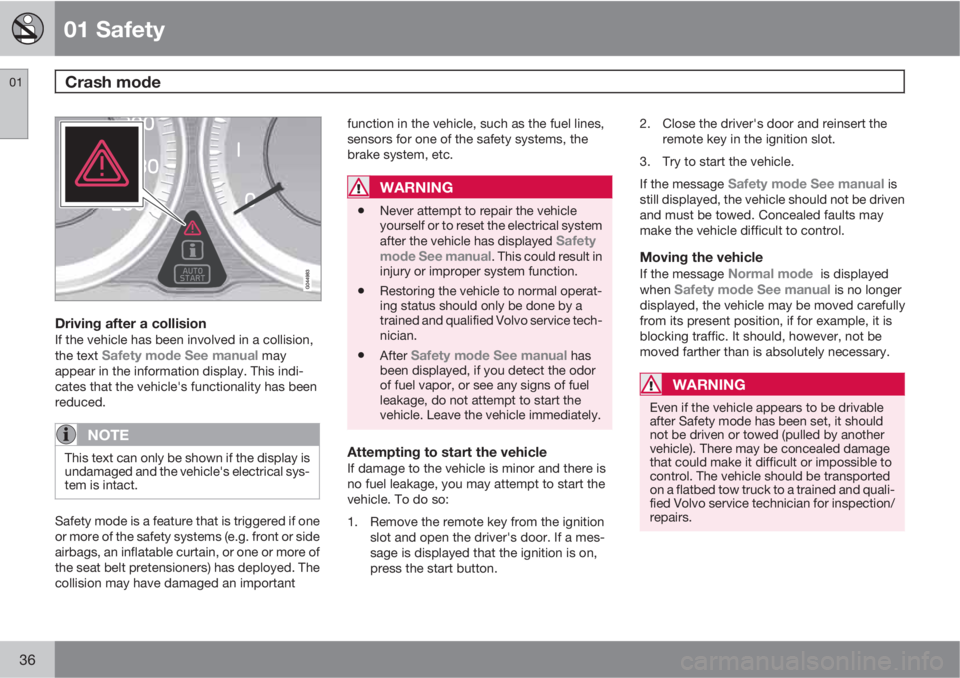
01 Safety
Crash mode 01
36
Driving after a collisionIf the vehicle has been involved in a collision,
the text Safety mode See manual may
appear in the information display. This indi-
cates that the vehicle's functionality has been
reduced.
NOTE
This text can only be shown if the display is
undamaged and the vehicle's electrical sys-
tem is intact.
Safety mode is a feature that is triggered if one
or more of the safety systems (e.g. front or side
airbags, an inflatable curtain, or one or more of
the seat belt pretensioners) has deployed. The
collision may have damaged an importantfunction in the vehicle, such as the fuel lines,
sensors for one of the safety systems, the
brake system, etc.
WARNING
•Never attempt to repair the vehicle
yourself or to reset the electrical system
after the vehicle has displayed
Safety
mode See manual. This could result in
injury or improper system function.
•Restoring the vehicle to normal operat-
ing status should only be done by a
trained and qualified Volvo service tech-
nician.
•After Safety mode See manual has
been displayed, if you detect the odor
of fuel vapor, or see any signs of fuel
leakage, do not attempt to start the
vehicle. Leave the vehicle immediately.
Attempting to start the vehicleIf damage to the vehicle is minor and there is
no fuel leakage, you may attempt to start the
vehicle. To do so:
1. Remove the remote key from the ignition
slot and open the driver's door. If a mes-
sage is displayed that the ignition is on,
press the start button.2. Close the driver's door and reinsert the
remote key in the ignition slot.
3. Try to start the vehicle.
If the message
Safety mode See manual is
still displayed, the vehicle should not be driven
and must be towed. Concealed faults may
make the vehicle difficult to control.
Moving the vehicle
If the message Normal mode is displayed
when Safety mode See manual is no longer
displayed, the vehicle may be moved carefully
from its present position, if for example, it is
blocking traffic. It should, however, not be
moved farther than is absolutely necessary.
WARNING
Even if the vehicle appears to be drivable
after Safety mode has been set, it should
not be driven or towed (pulled by another
vehicle). There may be concealed damage
that could make it difficult or impossible to
control. The vehicle should be transported
on a flatbed tow truck to a trained and quali-
fied Volvo service technician for inspection/
repairs.
Page 40 of 366
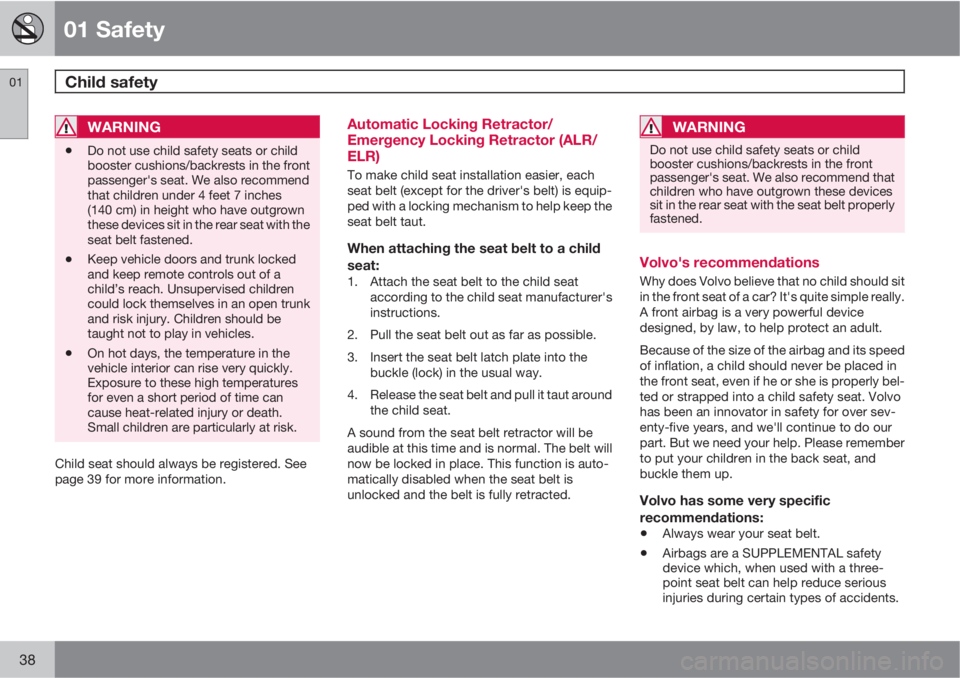
01 Safety
Child safety 01
38
WARNING
•Do not use child safety seats or child
booster cushions/backrests in the front
passenger's seat. We also recommend
that children under 4 feet 7 inches
(140 cm) in height who have outgrown
these devices sit in the rear seat with the
seat belt fastened.
•Keep vehicle doors and trunk locked
and keep remote controls out of a
child’s reach. Unsupervised children
could lock themselves in an open trunk
and risk injury. Children should be
taught not to play in vehicles.
•On hot days, the temperature in the
vehicle interior can rise very quickly.
Exposure to these high temperatures
for even a short period of time can
cause heat-related injury or death.
Small children are particularly at risk.
Child seat should always be registered. See
page 39 for more information.
Automatic Locking Retractor/
Emergency Locking Retractor (ALR/
ELR)
To make child seat installation easier, each
seat belt (except for the driver's belt) is equip-
ped with a locking mechanism to help keep the
seat belt taut.
When attaching the seat belt to a child
seat:
1. Attach the seat belt to the child seat
according to the child seat manufacturer's
instructions.
2. Pull the seat belt out as far as possible.
3. Insert the seat belt latch plate into the
buckle (lock) in the usual way.
4. Release the seat belt and pull it taut around
the child seat.
A sound from the seat belt retractor will be
audible at this time and is normal. The belt will
now be locked in place. This function is auto-
matically disabled when the seat belt is
unlocked and the belt is fully retracted.
WARNING
Do not use child safety seats or child
booster cushions/backrests in the front
passenger's seat. We also recommend that
children who have outgrown these devices
sit in the rear seat with the seat belt properly
fastened.
Volvo's recommendations
Why does Volvo believe that no child should sit
in the front seat of a car? It's quite simple really.
A front airbag is a very powerful device
designed, by law, to help protect an adult.
Because of the size of the airbag and its speed
of inflation, a child should never be placed in
the front seat, even if he or she is properly bel-
ted or strapped into a child safety seat. Volvo
has been an innovator in safety for over sev-
enty-five years, and we'll continue to do our
part. But we need your help. Please remember
to put your children in the back seat, and
buckle them up.
Volvo has some very specific
recommendations:
•Always wear your seat belt.
•Airbags are a SUPPLEMENTAL safety
device which, when used with a three-
point seat belt can help reduce serious
injuries during certain types of accidents.
Page 51 of 366

01 Safety
Child safety locks01
49 Child safety locks
Child safety locks – rear doorsThe controls are located on the rear door
jambs. Use the remote control's key blade or a
screwdriver to adjust these controls.
The rear doors can only be opened from
the outside when the slot is in the horizon-
tal position.
The rear doors can be opened from the
inside when the slot is in the vertical posi-
tion.
Page 54 of 366
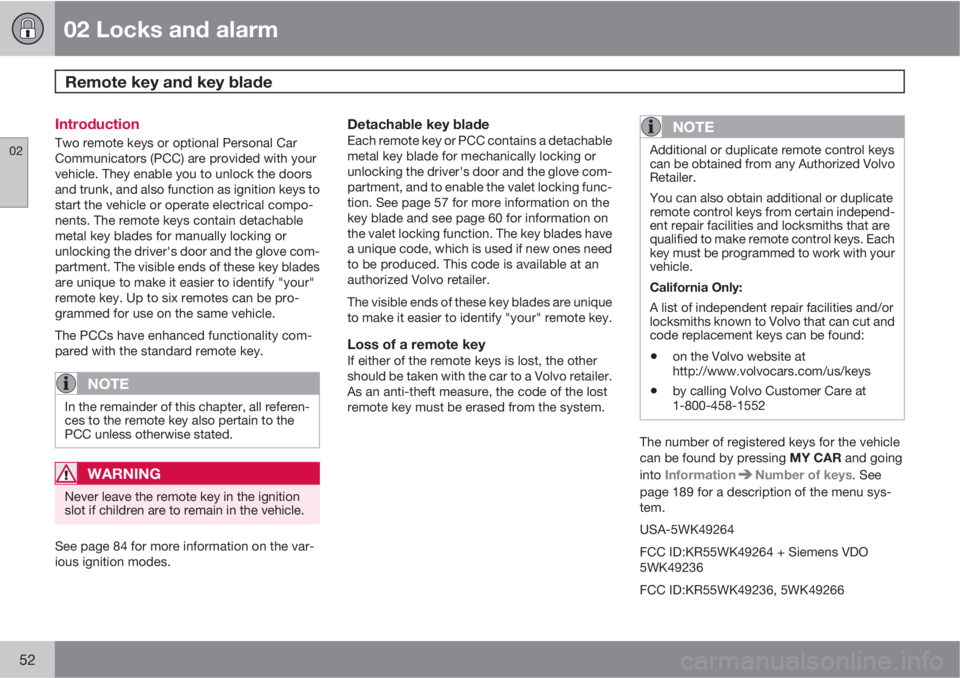
02 Locks and alarm
Remote key and key blade
02
52
Introduction
Two remote keys or optional Personal Car
Communicators (PCC) are provided with your
vehicle. They enable you to unlock the doors
and trunk, and also function as ignition keys to
start the vehicle or operate electrical compo-
nents. The remote keys contain detachable
metal key blades for manually locking or
unlocking the driver's door and the glove com-
partment. The visible ends of these key blades
are unique to make it easier to identify "your"
remote key. Up to six remotes can be pro-
grammed for use on the same vehicle.
The PCCs have enhanced functionality com-
pared with the standard remote key.
NOTE
In the remainder of this chapter, all referen-
ces to the remote key also pertain to the
PCC unless otherwise stated.
WARNING
Never leave the remote key in the ignition
slot if children are to remain in the vehicle.
See page 84 for more information on the var-
ious ignition modes.
Detachable key bladeEach remote key or PCC contains a detachable
metal key blade for mechanically locking or
unlocking the driver's door and the glove com-
partment, and to enable the valet locking func-
tion. See page 57 for more information on the
key blade and see page 60 for information on
the valet locking function. The key blades have
a unique code, which is used if new ones need
to be produced. This code is available at an
authorized Volvo retailer.
The visible ends of these key blades are unique
to make it easier to identify "your" remote key.
Loss of a remote keyIf either of the remote keys is lost, the other
should be taken with the car to a Volvo retailer.
As an anti-theft measure, the code of the lost
remote key must be erased from the system.
NOTE
Additional or duplicate remote control keys
can be obtained from any Authorized Volvo
Retailer.
You can also obtain additional or duplicate
remote control keys from certain independ-
ent repair facilities and locksmiths that are
qualified to make remote control keys. Each
key must be programmed to work with your
vehicle.
California Only:
A list of independent repair facilities and/or
locksmiths known to Volvo that can cut and
code replacement keys can be found:
•on the Volvo website at
http://www.volvocars.com/us/keys
•by calling Volvo Customer Care at
1-800-458-1552
The number of registered keys for the vehicle
can be found by pressing MY CAR and going
into Information
Number of keys. See
page 189 for a description of the menu sys-
tem.
USA-5WK49264
FCC ID:KR55WK49264 + Siemens VDO
5WK49236
FCC ID:KR55WK49236, 5WK49266
Page 56 of 366

02 Locks and alarm
Remote key and key blade
02
54
Lock indicator
Lock/alarm indicator light
A flashing indicator light at the base of the
windshield verifies that the vehicle is locked.
Immobilizer (start inhibitor)Each of the keys supplied with your vehicle
contains a coded transponder. The code in the
key is transmitted to an antenna in the ignition
slot where it is compared to the code stored in
the start inhibitor module. The vehicle will start
only with a properly coded key. If you misplace
a key, take the other keys to a trained and
qualified Volvo service technician for reprog-
ramming as an anti-theft measure. The follow-
ing messages (which may appear in the instru-
ment panel display) are related to the immobil-
izer:
MessageMeaning
Insert car keyRemote key not rec-
ognized during start.
Try to start the vehi-
cle again.
Car key not foundPCC with keyless
drive only. Remote
key not recognized
during start. Try to
start the vehicle
again.
If the problem con-
tinues, insert the
remote key into the
ignition slot and try
to start the vehicle
again.
Immobilizer Try
start againRemote key fault
during start. Contact
an authorized Volvo
workshop.
CAUTION
Never use force when inserting the remote
key in the ignition slot. The vehicle cannot
be started if the transponder is damaged.
USA–FCC ID: LTQWFS 125VOThis device complies with part 15 of the FCC
rules. Operation is subject to the following con-
dition: (1) This device may not cause harmful
interference, and (2) this device must accept
any interference received, including interfer-
ence that may cause undesired operation.
Canada–IC: 3659A-WFS125VO
Operation is subject to the following condi-
tions: (1) this device may not cause interfer-
ence, and (2) this device must accept any inter-
ference, including interference that may cause
undesired operation of the device.
See page 113 for information on starting the
vehicle.
Replacing the battery in the remote keyThe batteries should be replaced if:
•The information symbol illuminates andLow battery in remote control. Please
change batteries. is shown in the display
and/or
•if the locks do not react after several
attempts to unlock or lock the vehicle.
NOTE
The remote key's range is normally approx-
imately 60 ft (20 m) from the vehicle.
See page 58 for information about replacing
the battery.
Page 59 of 366

02 Locks and alarm
Remote key and key blade
02
57
NOTE
If none of the indicator lights flash when the
information button has been pressed sev-
eral times from different places in relation to
the vehicle, contact an authorized Volvo
service technician.
The indicator lights provide information
according to the illustration:
Steady green light: the vehicle is correctly
locked.
Steady yellow light: the vehicle is not
locked.
Steady red light: the alarm has been trig-
gered since the vehicle was most recently
locked.
Both red lights flash alternatively: the alarm
was triggered less than 5 minutes ago.
RangeThe PCC's lock and unlock functions have a
range of approximately 60 ft. (20 m) from the
vehicle.
NOTE
•The approach lighting, panic alarm, and
the functions controlled by the informa-
tion button have a range of approxi-
mately 300 ft (100 m) from the vehicle.
•Radio waves, buildings or other obsta-
cles may interfere with the function of
the PCC.
If the vehicle does not provide confirmation
when a button has been pressed, try moving
closer and pressing the button again.
Outside of the PCC´s rangeIf the PCC is more than approximately 300 ft
(100 m) from the vehicle when the information
button is pressed, no new information will be
received. The PCC most recently used to lock
or unlock the vehicle will show the vehicle's
most recently received status. The indicator
lights will not flash when the information button
is pressed while the PCC is out of range.
If more than one PCC is used to lock/unlock
the vehicle, only the one used most recently will
show the correct locking status.
NOTE
If none of the indicator lights illuminate when
the information button is pressed, this may
be because the most recent transmission
between the vehicle and the PCC was inter-
rupted or impeded by buildings or other
objects.
Keyless driveVehicles equipped with the optional Personal
Car Communicator have the keyless drive
function, see page 61 for detailed informa-
tion.
Detachable key blade
The key blade can be removed from the remote
key. When removed, the key blade can be used
to:
•Lock/unlock the driver's door if the remote
key is not functioning properly
•Lock/unlock the glove compartment (see
page 67)
•Override the transmission's shiftlock sys-
tem (see page 120)
•Enable/disable the valet locking function
(see page 60)
Page 63 of 366
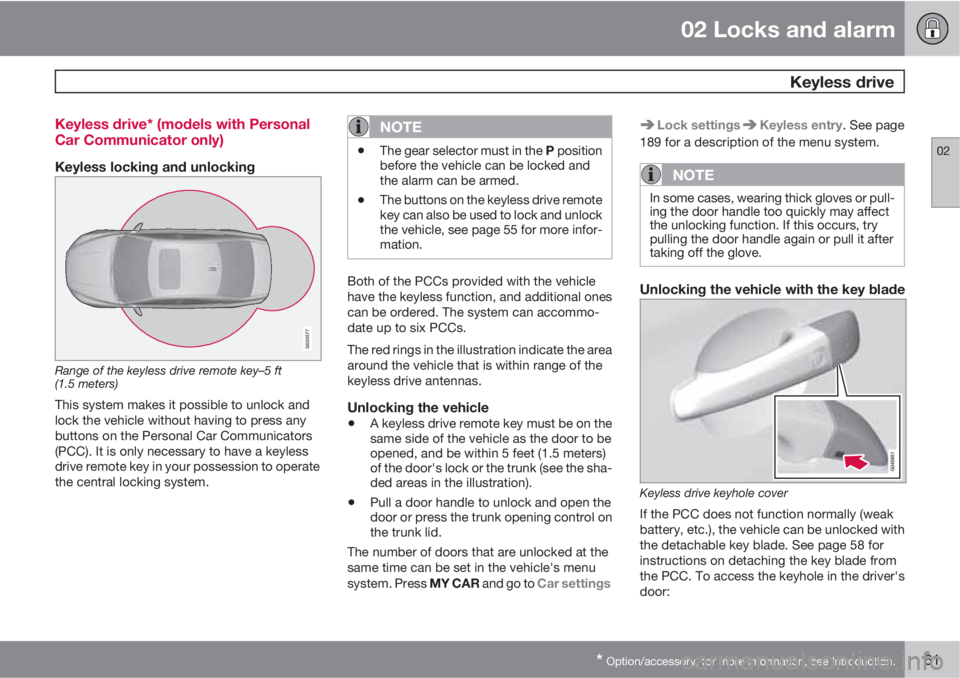
02 Locks and alarm
Keyless drive
02
* Option/accessory, for more information, see Introduction.61 Keyless drive* (models with Personal
Car Communicator only)
Keyless locking and unlocking
G020577
Range of the keyless drive remote key–5 ft
(1.5 meters)
This system makes it possible to unlock and
lock the vehicle without having to press any
buttons on the Personal Car Communicators
(PCC). It is only necessary to have a keyless
drive remote key in your possession to operate
the central locking system.
NOTE
•The gear selector must in the P position
before the vehicle can be locked and
the alarm can be armed.
•The buttons on the keyless drive remote
key can also be used to lock and unlock
the vehicle, see page 55 for more infor-
mation.
Both of the PCCs provided with the vehicle
have the keyless function, and additional ones
can be ordered. The system can accommo-
date up to six PCCs.
The red rings in the illustration indicate the area
around the vehicle that is within range of the
keyless drive antennas.
Unlocking the vehicle
•A keyless drive remote key must be on the
same side of the vehicle as the door to be
opened, and be within 5 feet (1.5 meters)
of the door's lock or the trunk (see the sha-
ded areas in the illustration).
•Pull a door handle to unlock and open the
door or press the trunk opening control on
the trunk lid.
The number of doors that are unlocked at the
same time can be set in the vehicle's menu
system. Press MY CAR and go to Car settings
Lock settingsKeyless entry. See page
189 for a description of the menu system.
NOTE
In some cases, wearing thick gloves or pull-
ing the door handle too quickly may affect
the unlocking function. If this occurs, try
pulling the door handle again or pull it after
taking off the glove.
Unlocking the vehicle with the key blade
Keyless drive keyhole cover
If the PCC does not function normally (weak
battery, etc.), the vehicle can be unlocked with
the detachable key blade. See page 58 for
instructions on detaching the key blade from
the PCC. To access the keyhole in the driver's
door:
Page 64 of 366
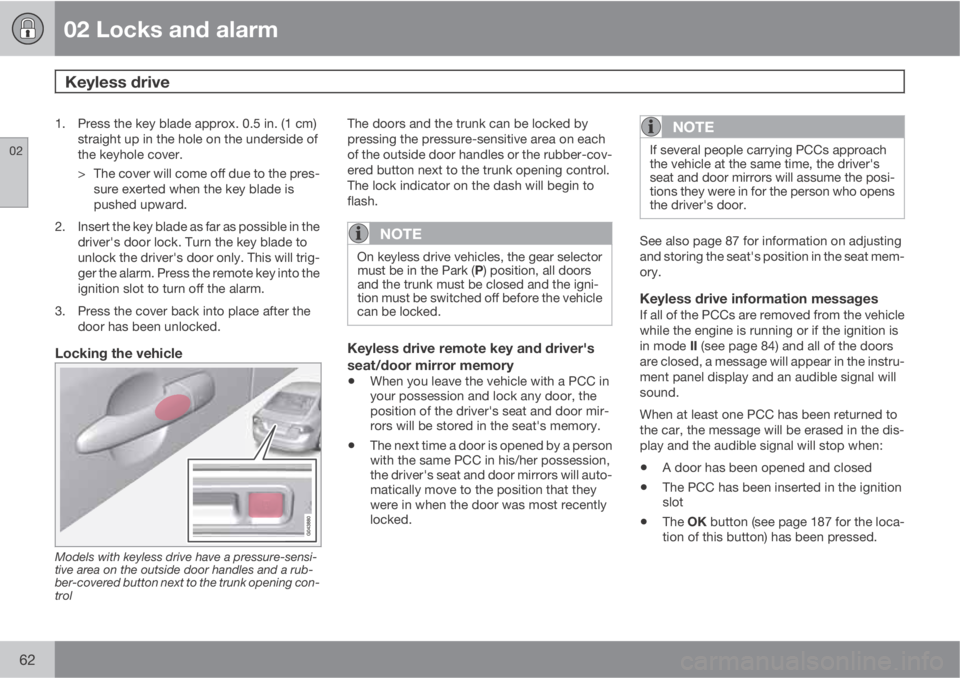
02 Locks and alarm
Keyless drive
02
62
1. Press the key blade approx. 0.5 in. (1 cm)
straight up in the hole on the underside of
the keyhole cover.
> The cover will come off due to the pres-
sure exerted when the key blade is
pushed upward.
2. Insert the key blade as far as possible in the
driver's door lock. Turn the key blade to
unlock the driver's door only. This will trig-
ger the alarm. Press the remote key into the
ignition slot to turn off the alarm.
3. Press the cover back into place after the
door has been unlocked.
Locking the vehicle
Models with keyless drive have a pressure-sensi-
tive area on the outside door handles and a rub-
ber-covered button next to the trunk opening con-
trol
The doors and the trunk can be locked by
pressing the pressure-sensitive area on each
of the outside door handles or the rubber-cov-
ered button next to the trunk opening control.
The lock indicator on the dash will begin to
flash.
NOTE
On keyless drive vehicles, the gear selector
must be in the Park (P) position, all doors
and the trunk must be closed and the igni-
tion must be switched off before the vehicle
can be locked.
Keyless drive remote key and driver's
seat/door mirror memory
•When you leave the vehicle with a PCC in
your possession and lock any door, the
position of the driver's seat and door mir-
rors will be stored in the seat's memory.
•The next time a door is opened by a person
with the same PCC in his/her possession,
the driver's seat and door mirrors will auto-
matically move to the position that they
were in when the door was most recently
locked.
NOTE
If several people carrying PCCs approach
the vehicle at the same time, the driver's
seat and door mirrors will assume the posi-
tions they were in for the person who opens
the driver's door.
See also page 87 for information on adjusting
and storing the seat's position in the seat mem-
ory.
Keyless drive information messagesIf all of the PCCs are removed from the vehicle
while the engine is running or if the ignition is
in mode II (see page 84) and all of the doors
are closed, a message will appear in the instru-
ment panel display and an audible signal will
sound.
When at least one PCC has been returned to
the car, the message will be erased in the dis-
play and the audible signal will stop when:
•A door has been opened and closed
•The PCC has been inserted in the ignition
slot
•The OK button (see page 187 for the loca-
tion of this button) has been pressed.
Page 89 of 366
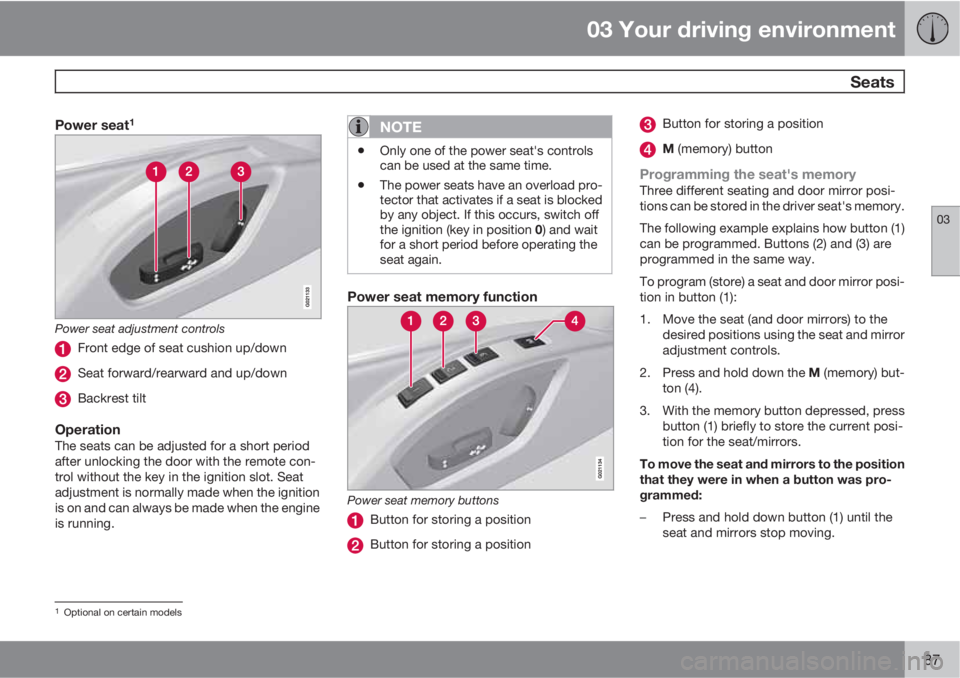
03 Your driving environment
Seats
03
87
Power seat1
Power seat adjustment controls
Front edge of seat cushion up/down
Seat forward/rearward and up/down
Backrest tilt
OperationThe seats can be adjusted for a short period
after unlocking the door with the remote con-
trol without the key in the ignition slot. Seat
adjustment is normally made when the ignition
is on and can always be made when the engine
is running.
NOTE
•Only one of the power seat's controls
can be used at the same time.
•The power seats have an overload pro-
tector that activates if a seat is blocked
by any object. If this occurs, switch off
the ignition (key in position 0) and wait
for a short period before operating the
seat again.
Power seat memory function
Power seat memory buttons
Button for storing a position
Button for storing a position
Button for storing a position
M (memory) button
Programming the seat's memoryThree different seating and door mirror posi-
tions can be stored in the driver seat's memory.
The following example explains how button (1)
can be programmed. Buttons (2) and (3) are
programmed in the same way.
To program (store) a seat and door mirror posi-
tion in button (1):
1. Move the seat (and door mirrors) to the
desired positions using the seat and mirror
adjustment controls.
2.
Press and hold down the M (memory) but-
ton (4).
3. With the memory button depressed, press
button (1) briefly to store the current posi-
tion for the seat/mirrors.
To move the seat and mirrors to the position
that they were in when a button was pro-
grammed:
–Press and hold down button (1) until the
seat and mirrors stop moving.
1Optional on certain models